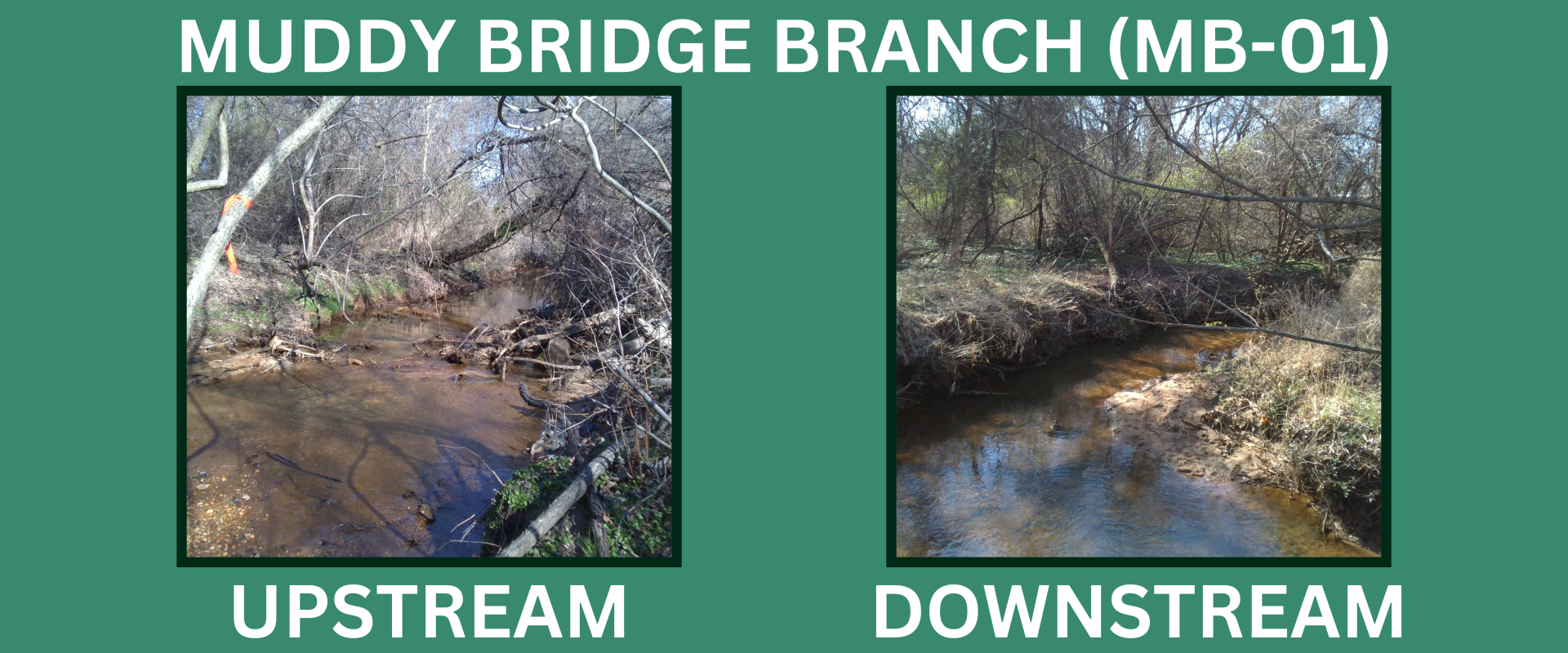
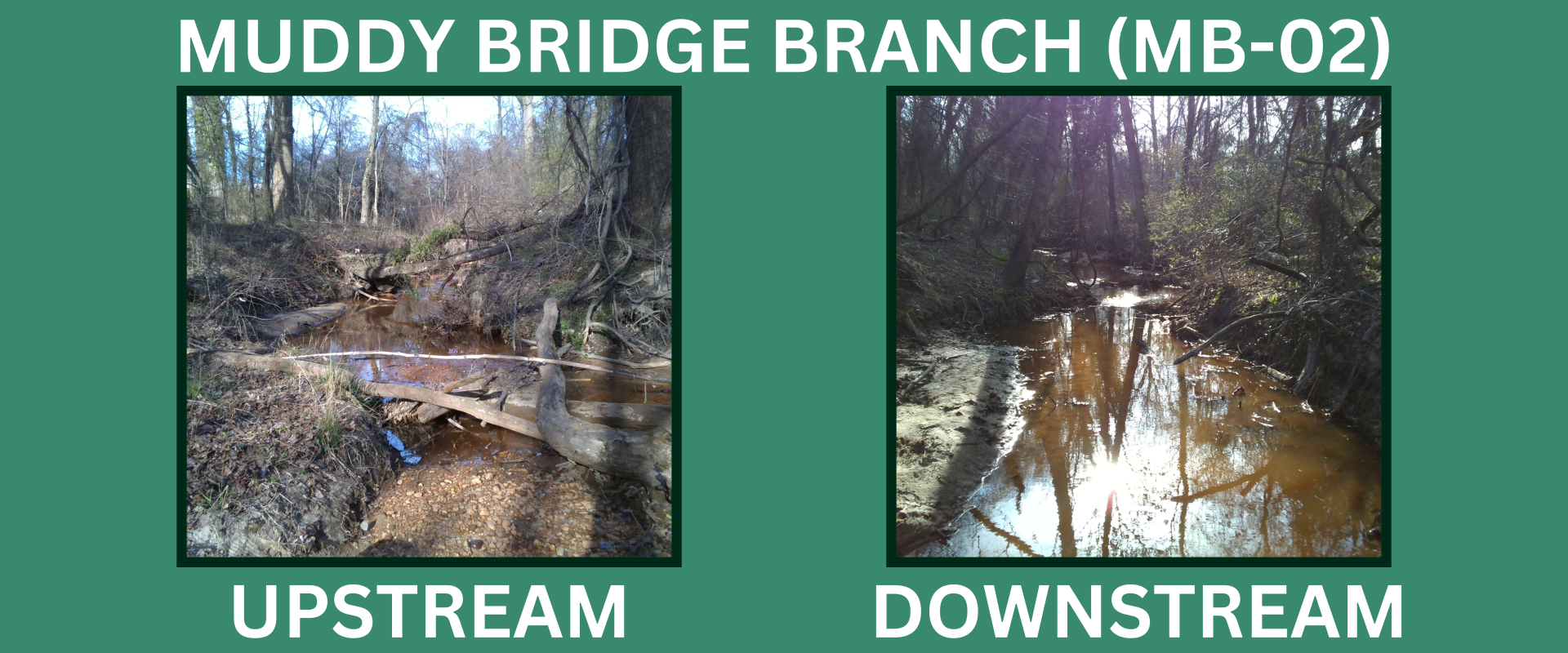
| Site MB-01 | |||
|---|---|---|---|
| Time Frame | BIBI (Condition) | FIBI (Condition)a | RBP (Condition) |
| 2024 Results | 2.71 (Poor) | 4.33 (Good) | 124 (Partially Supporting) |
| Cumulative Avg. (2017-2024) | 2.21 (Poor) | 3.66 (Fair) | 119 (Partially Supporting) |
| 3-year Running Average | 2.43 (Poor) | 3.78 (Fair) | 114 (Partially Supporting) |
a) Fish data collected in 2018, 2020, 2022, and 2024.
| Site MB-02 | |||
|---|---|---|---|
| Time Frame | BIBI (Condition) | FIBI (Condition)a | RBP (Condition) |
| 2024 Results | 3.00 (Fair) | 3.33 (Fair) | 115 (Partially Supporting) |
| Cumulative Average (2017-2024) | 1.89 (Very Poor) | 2.25 (Poor) | 101 (Partially Supporting) |
| 3-year Running Average | 2.33 (Poor) | 2.44 (Poor) | 98 (Non-Supporting) |
a) Fish data collected in 2018, 2020, and 2022.
Site MB-01: In 2023, MB-01 received a BIBI score of 2.71 (Poor), its highest score since 2018. BIBI scores at the site have rated “Poor” in six out of the eight years sampled, including the past five consecutive years. True flies have been the dominant organisms in the samples for six of the eight monitoring years, including 2024.
MB-01 Summary of Insects Collected by Sample Year:

Site MB-02: A BIBI score of 3.00 (Fair) was recorded at MB-02 in 2024, a significant improvement over previous years. 2024 marks the first year that the site has received a rating other than “Poor” or “Very Poor.” Like previous years, true flies and segmented worms were the dominant species in the 2024 sample, but the increasing numbers of beetle, caddisfly, and dragonfly species contributed to the observed improvement here.
MB-02 Summary of Insects Collected by Sample Year:
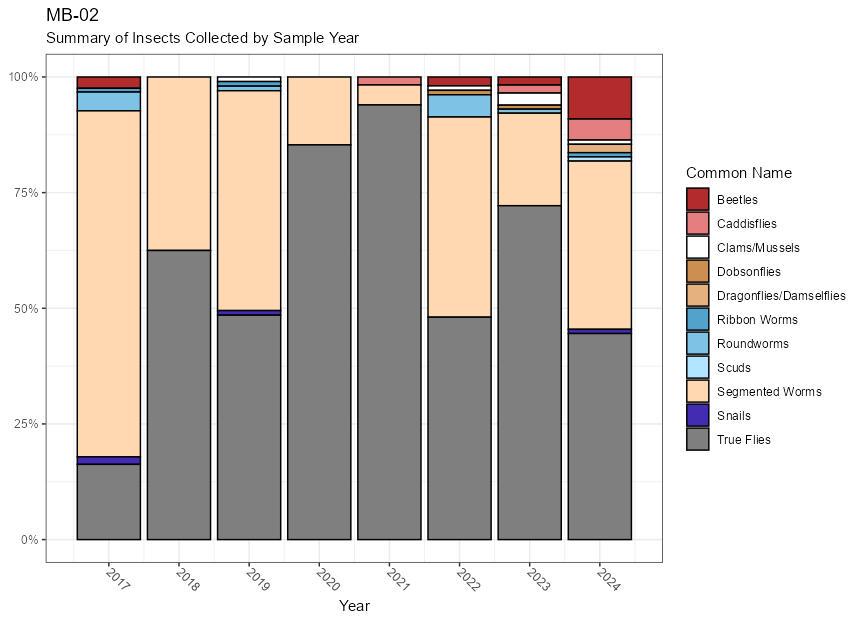
Site MB-01: The site received a FIBI score of 4.33 (“Good“) in 2024. FIBI scores for the site have been in either the “Fair” or “Good” categories in all four of the years it has been sampled. Ten different species were observed in 2024, with tessellated darter (Etheostoma olmstedi) and white sucker (Catostomus commersonii) being the most abundant. Twelve different fish species in total have been found at this site since 2018.
MB-01 Summary of Fish Collected by Sample Year:
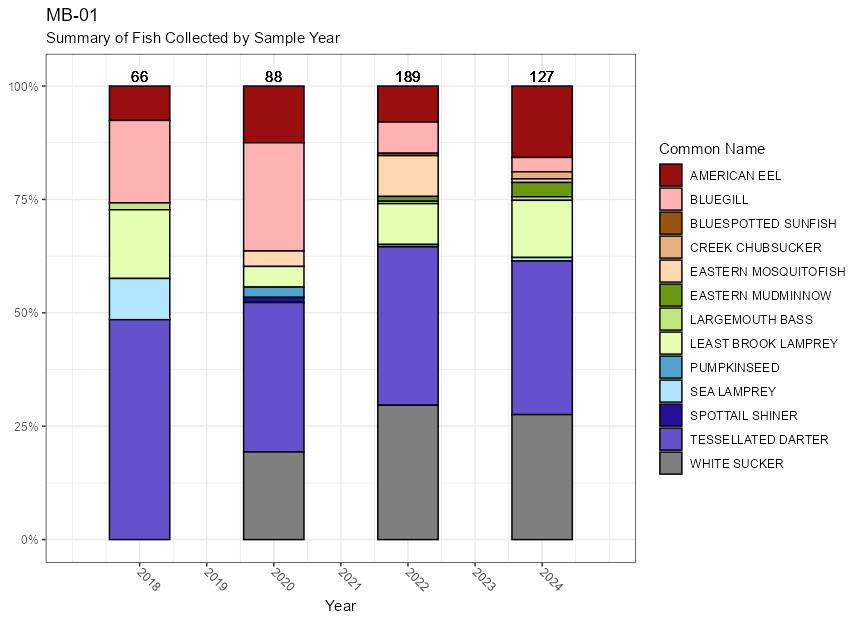
Site MB-02: The site received a FIBI score of 3.33 (Fair) in 2024, the first time the site has received a rating other than “Poor” or “Very Poor.” This improvement parallels the improvement seen in the benthic community at this site in 2024. White sucker (Catostomus commersonii) and tessellated darter (Etheostoma olmstedi) were the dominant species in the 2024 sample. American eel (Anguilla rostrata) and creek chubsucker (Erimyzon oblongus) were both observed for the first time at the site in 2024.
MB-02 Summary of Fish Collected by Sample Year:
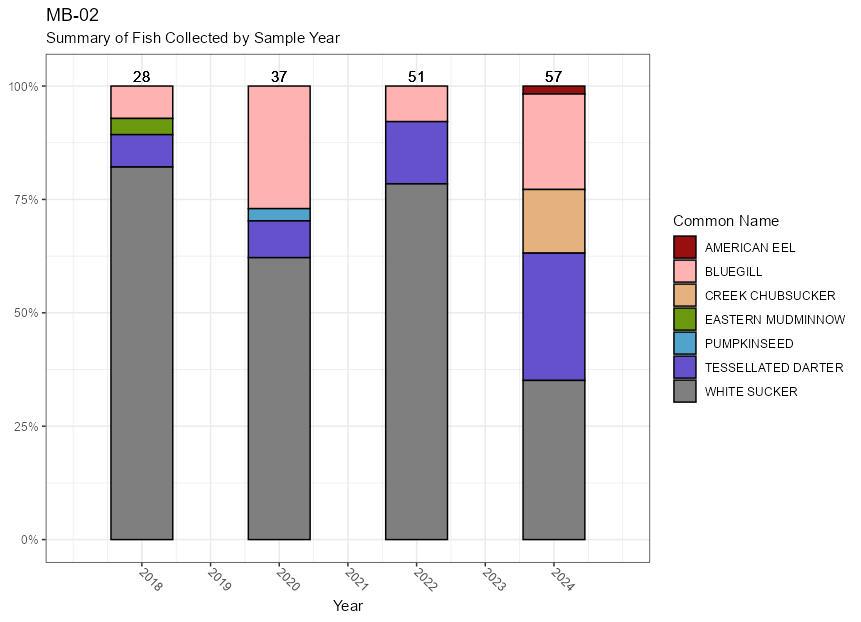
Site MB-01: In 2024, the site received an RBP score of 124 (Partially Supporting). Cumulative and three-year average RBP scores are 119 (Partially Supporting) and 114 (Partially Supporting), respectively.
Site MB-02: In 2023, the site received an RBP score of 115 (Partially Supporting). RBP ratings at the site have been in the “Non-Supporting” or “Partially Supporting” categories since 2018. Cumulative and three-year averages at the site are 101 (Partially Supporting) and 98 (Non-Supporting), respectively.
Site MB-01: A geomorphological assessment was not performed at the site in 2024 due to safety concerns. Between 2017 and 2022, the left bank retreated by approximately 1.5 ft due to erosion, while accretion of sediment on the right bank was observed. The channel bottom experienced slight downcutting (by about 0.5 ft) but appears to be relatively stable.
MB-01 Cross-Section Comparison:
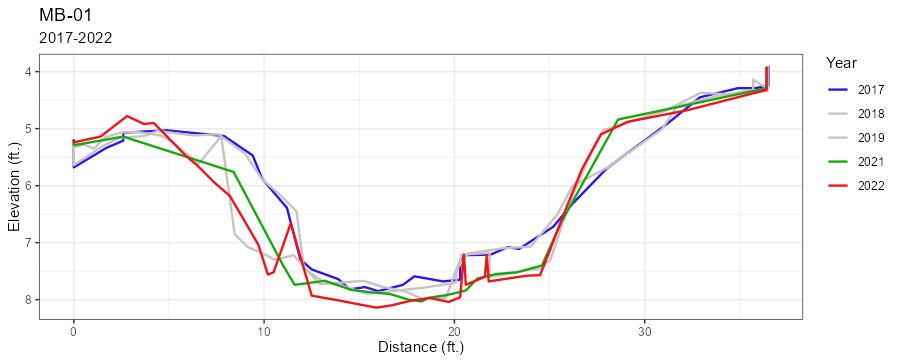
Site MB-02: Geomorphological assessments have been performed at the site annually since 2017. Slight erosion of the banks and downcutting of the channel has occurred here over time, particularly on the right bank, but channel shape and character have not changed too dramatically.
MB-02 Cross-Section Comparison:
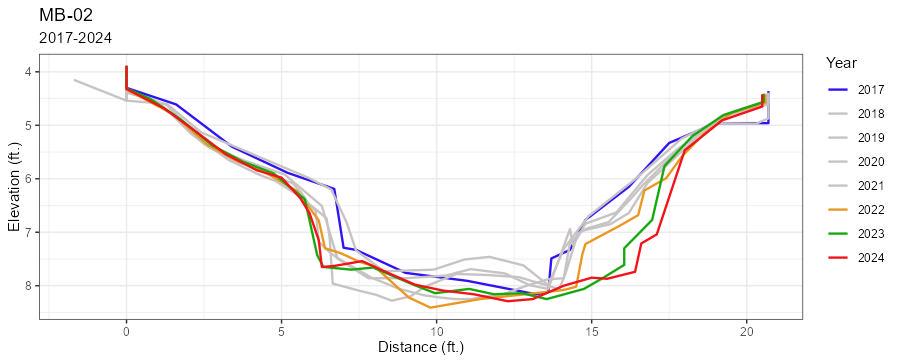
| MB-01 | |||
|---|---|---|---|
| Year | BIBI (Condition) | FIBI (Condition) | RPB (Condition) |
| 2017 | 1.29 (VP) | --- | 136 (S) |
| 2018 | 2.71 (P) | 3.33 (F) | 115 (PS) |
| 2019 | 1.86 (VP) | -- | 110 (PS) |
| 2020 | 2.14 (P) | 3.00 (F) | 140 (S) |
| 2021 | 2.43 (P) | -- | 111 (PS) |
| 2022 | 2.14 (P) | 4.00 (G) | 106 (PS) |
| 2023 | 2.43 (P) | -- | 113 (PS) |
2024 | 2.71 (P) | 4.33 (G) | 124 (PS) |
| MB-02 | |||
|---|---|---|---|
| Year | BIBI (Condition) | FIBI (Condition) | RBP (Condition) |
| 2017 | 2.14 (S) | -- | 129 (S) |
| 2018 | 1.00 (VP) | 1.67 (VP) | 89 (NS) |
| 2019 | 1.86 (VP) | --- | 106 (PS) |
| 2020 | 1.57 (VP) | 2.33 (P) | 86 (NS) |
| 2021 | 1.57 (VP) | --- | 101 (PS) |
| 2022 | 2.14 (P) | 1.67 (VP) | 94 (S) |
| 2023 | 1.86 (VP) | -- | 86 (NS) |
2024 | 3.00 (F) | 3.33 (F) | 115 (PS) |
| Station Summary | ||||||
|---|---|---|---|---|---|---|
| Average BIBI (SD) | 3-Year Average BIBI (SD) | Average RPB (SD) | 3-Year Average RBP (SD) | Average FIBI (SD) | 3-Year FIBI Average (SD) | |
| MB-01 | 2.21 (0.47) | 2.43 (0.29) | 119 (13) | 114 (9) | 3.66 (0.61) | 3.78 (0.69) |
| MB-02 | 1.89 (0.58) | 2.33 (0.59) | 101 (15) | 98 (15) | 2.25 (0.78) | 2.44 (0.84) |

